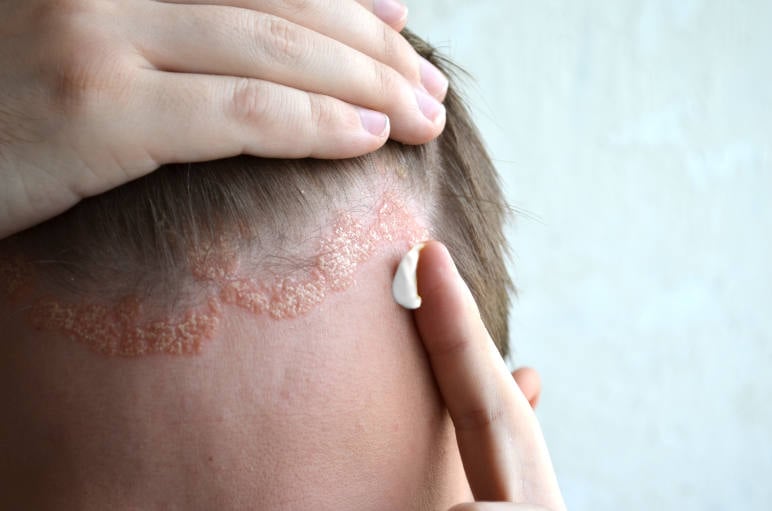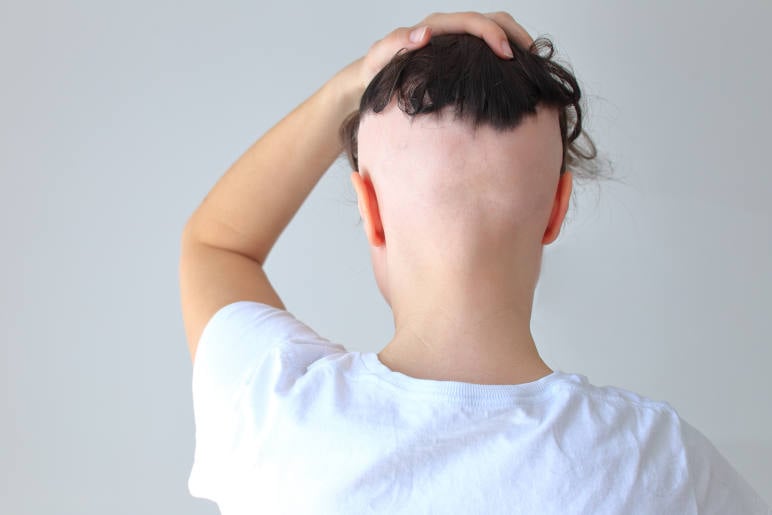
What is Frontal Fibrosing Alopecia?
In 1994, Professor Steven Kossard, a clinical dermatologist, first described frontal and temporal hair loss (with scarring) as Frontal Fibrosing Alopecia. It is identified by band-like hair loss that can also affect eyebrows and other facial hair, which is medically known as Cicatricial Alopecia.
This form of hair loss is slowly progressive, which sees the whole hairline gradually recede. This is different from male pattern baldness because with Frontal Fibrosing Alopecia the hairline recedes in a linear pattern. Whereas, in pattern hair loss, the hairline recedes in an “M” shape.
What Causes Frontal Fibrosing Alopecia?
Hormones, genetics and autoimmune diseases are all mentioned as causes of Frontal Fibrosing Alopecia (FFA), however, the cause is not yet fully understood. In most cases 1 of these factors is diagnosed as the cause, however, a combination of the 3 is also possible for this type of alopecia.
Studies have suggested that mainly post-menopausal women get FFA which has been the main indicator for it being hormonal based, although incidence is said to be increasing globally in all demographics. The lack of oestrogen or a hormonal shift has therefore been thought to be a cause of Frontal Fibrosing Alopecia. However, it’s frequently reported in both men and women with autoimmune diseases. Autoimmune diseases include rheumatoid arthritis, thyroid disease and lupus.
Other causes of FFA
Furthermore, clinical studies blame an inflammatory autoimmune reaction for frontal and temporal hair loss. Additionally, there is substantial evidence that FFA existed way before Kossard’s discovery, since artistic portraits from the 15th and 16th centuries often show a fashionable receded frontal hairline. Although there are suggestions that this is from Traction Alopecia rather than FFA.
In recent studies, leave on cosmetics such as sunscreen or makeup have been seen to have a potential link to the cause of FFA. This is because it can be seen to be in line with the rise in cases as these products have become more popularised in the last few decades.
How is FFA related to Lichen Planopilaris (LPP)?
Frontal Fibrosing Alopecia is a form of Lichen Planopilaris. Other names for it include follicular lichen planus, Axel Munthe’s Syndrome and Kossard’s disease. According to the Genetic and Rare Diseases Information Center, there are 3 types of LPP; the classic Lichen Planopilaris, FFA, and Lassueur Graham-Little Piccardi Syndrome.
The cause of LPP is unknown, however, it’s thought to be caused by an autoimmune disease. Like with LLP, the sebaceous gland which is in the same area as the stem cell region of the follicle is the target of inflammation. The main signs and symptoms of this medical condition are tiny red bumps around your hair follicles that can cause itchiness, pain and a burning sensation, later resulting in a permanent loss of hair.
Follicular Lichen Planopilaris causes scarring, which leads to permanent hair loss along the frontal hairline. Thus, a lichen planopilaris scalp infection leads to Frontal Fibrosing Alopecia.

Is this condition rare?
Frontal Fibrosing Alopecia is a rare condition, however, the number of known cases is increasing. The average age that women start to experience symptoms is 64 however it’s also been recorded in premenopausal women. Thus, the condition is also known as Postmenopausal Lichen Planopilaris (PLPP).
FFA is rarely seen in men. However, when genetic factors are involved, then it’s more commonly seen in men.
The symptoms of FFA cause significant psychological distress and social anxiety, which warrants further research into the cause and treatment of this type of scarring hair loss.
What Are the Symptoms?
The signs and symptoms of Frontal Fibrosing Alopecia last for a few years, whereby the loss of hair is slowly progressive, unlike other types of alopecia areata that are sudden and cyclical. Symptoms only present in the frontal and temporal hairline, which gradually turns bald with scarring alopecia. While the pattern is typically uniform, it can include a zigzag appearance or continuous receding all around the head. After a few years, the condition spontaneously stabilises, however, hair growth cannot naturally return.
The symptoms include:
- Hair loss in a band-like pattern along the forehead and temples
- Lone hairs within the affected area
- Occasionally it spreads to other parts of the body, including loss of eyebrows and eyelashes
- Scarred skin after total hair loss in this area
As the condition continues over time, hair can be lost in extremity areas on the arms and legs. While this is often seen as a sign of natural ageing, with Frontal Fibrosing Alopecia the hair loss can be patchy and totally lacking in hair. The nearby hair follicles will have lost their redness and scaling typical of the area where the hair loss has occurred.
How do you know if you have frontal fibrosing alopecia?
Peri follicular inflammation occurs along the hairline, which affects the growth of your hair. As the number of hair follicles decreases, they are replaced with fibrosis. You will know if you have FFA if you notice that your frontal hairline has signs of scarring.
The skin in the area affected by FFA will show a lack of sun damage on your forehead that is typically seen. This can help to show the extent of the hairline recession. The diagnosis of Frontal Fibrosing Alopecia is established through a skin biopsy, which analyses whether Lichen Planopilaris is present. Areas with remaining hairs are studied to find evidence of scalp inflammation.
The area that has a lack of hair will be pale and shiny with the lack of visible follicle openings. In men, loss of hair in the beard area can be possible. Early signs of FFA can be itching and pain in the area with discoloured skin on the forehead and temples.

How Do You Treat Frontal Fibrosing Alopecia?
Due to the lack of research about FFA, scientists haven’t discovered a cure for this type of hair loss. Many women look towards using the best hairstyles for frontal fibrosing alopecia like an asymmetrical bob or long bangs in order to cover the condition. However, the British Association of Dermatologists have identified several treatment options, but their success is variable, and sometimes no treatment is effective.
Early diagnosis is important in order to prevent long term damage to the hair follicles. Managing the condition can be complex, as treatment can be different for each person. As it is often slowly progressive, it can be resolved on its own after several years in some cases.
Treatments include:
- Topical corticoteroids (steroid cream)
- Intralesional steroids (steroid injections)
- Immunotheraphy
- Finasteride
- Topical Tacrolimus
- Antibiotics
A SDHI hair transplant is sometimes considered for treating Frontal Fibrosing Alopecia, however, it is only possible if your condition has stabilised. The SDHI method works well for restoring hair lost in the hairline region, as it offers precision while also restoring density to the affected regions of hair loss.
Whether hair can be restored with surgery depends on the cause as well. Therefore, you will need to consult a doctor/hair loss expert for an assessment.
Conclusion
Frontal Fibrosing Alopecia is caused by Lichen Planopilaris which causes red, itchy bumps and inflammation above and below the surface of the scalp. The inflammation destroys the hair follicles along the hairline, which causes permanent scarring in a band-like pattern.
Overall, the cause of the condition is unknown because it is rare, therefore treatments haven’t been widely studied. Doctors have found some effective remedies, however, the success rate varies from patient to patient.
Do you have more questions or are you looking for a permanent solution to your hair loss? Then don’t hesitate to contact our friendly team that will answer all your queries about getting a hair transplant. Furthermore, they can also offer a free and non-binding hair analysis.
FAQ
Can men be affected by frontal fibrosing alopecia (FFA)?
Yes, although FFA is more common in post-menopausal women, men can also be impacted, especially if genetic factors are involved.
What is the role of hormonal treatments in managing FFA?
Hormonal treatments, such as hormone replacement therapy, may help manage symptoms in post-menopausal women by addressing hormonal imbalances.
How can I prevent further hair loss if diagnosed with FFA?
Early diagnosis and treatment are crucial. Avoiding hairstyling practices that cause tension on the hairline and using gentle hair care products can help prevent further hair loss.
Are there any lifestyle changes that can help manage FFA?
Maintaining a healthy diet, managing stress, and avoiding potential triggers such as certain cosmetics may help manage FFA symptoms.
Is there a genetic test available for FFA?
Currently, there is no specific genetic test for FFA, but a thorough family history and consultation with a specialist can help assess the risk.
What is the psychological impact of FFA and how can it be addressed?
FFA can cause significant psychological distress and social anxiety. Support groups, counselling, and psychological therapy can help manage the emotional impact.


